#African Americans in Chinatown
Explore tagged Tumblr posts
Text
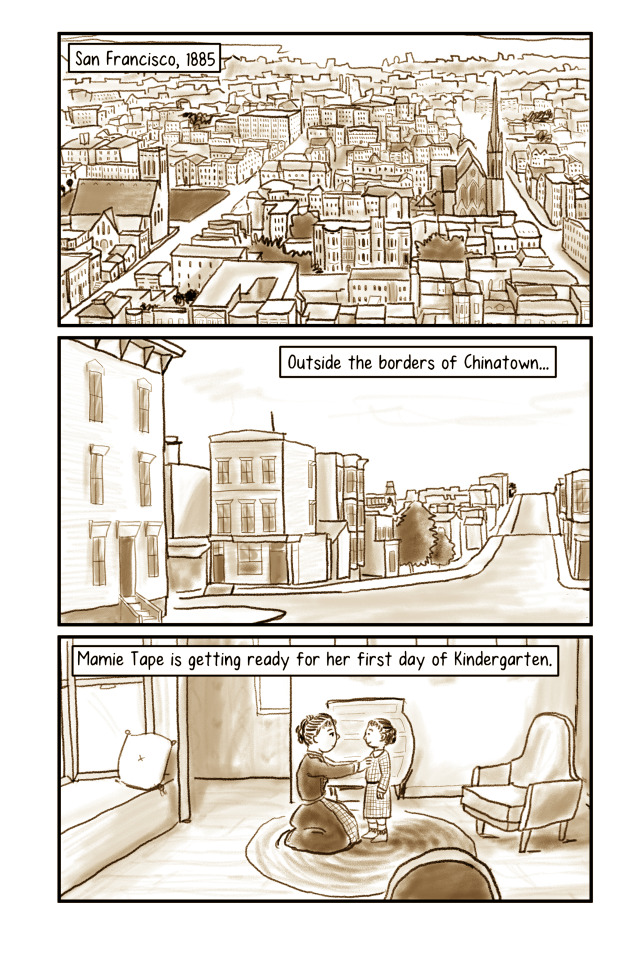
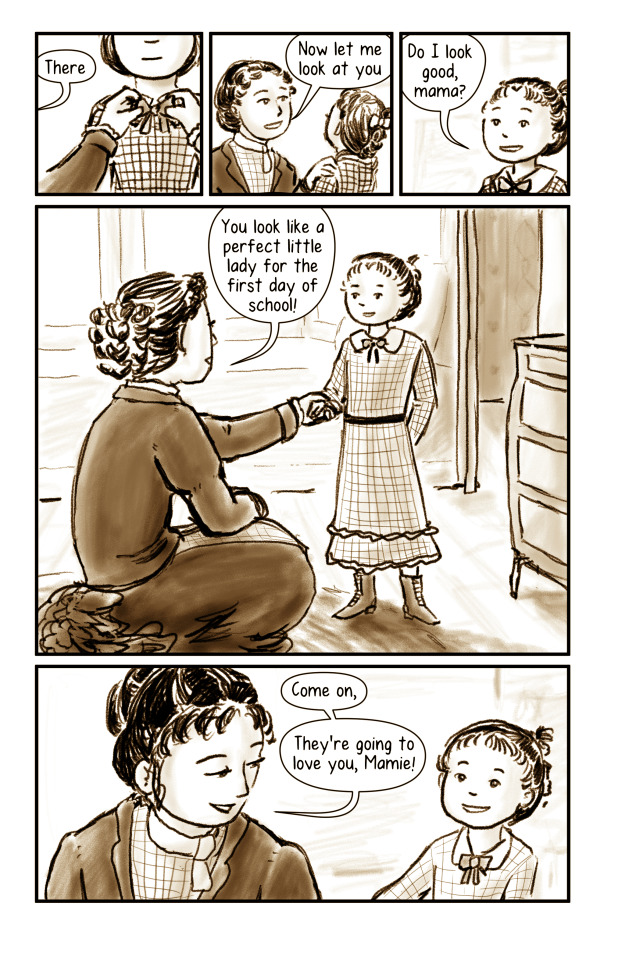
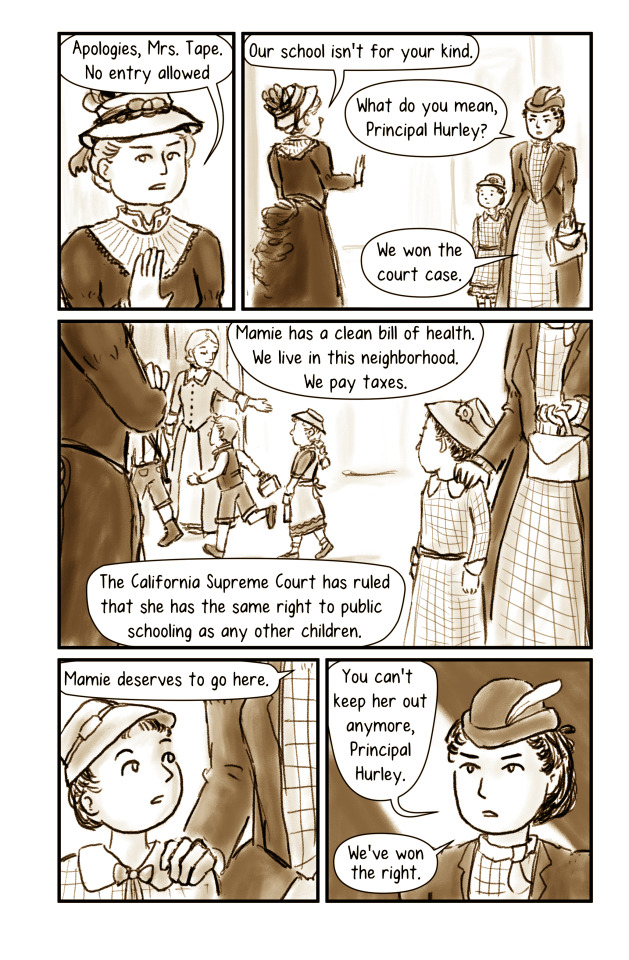
in my pursuit of ever-increasingly niche comics, I drew a 13 page comic about Tape v Hurley, a court case about Chinese-American school segregation in 1885. The rest of the pages are after the readmore, as well as on AO3 here. More obsure Chinese American court case comics are there, as well.
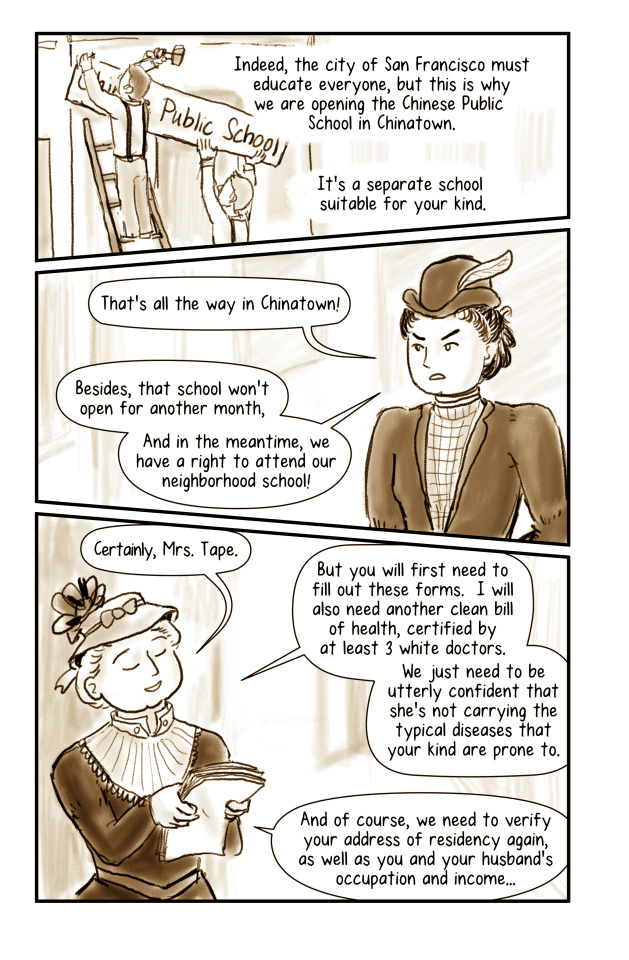
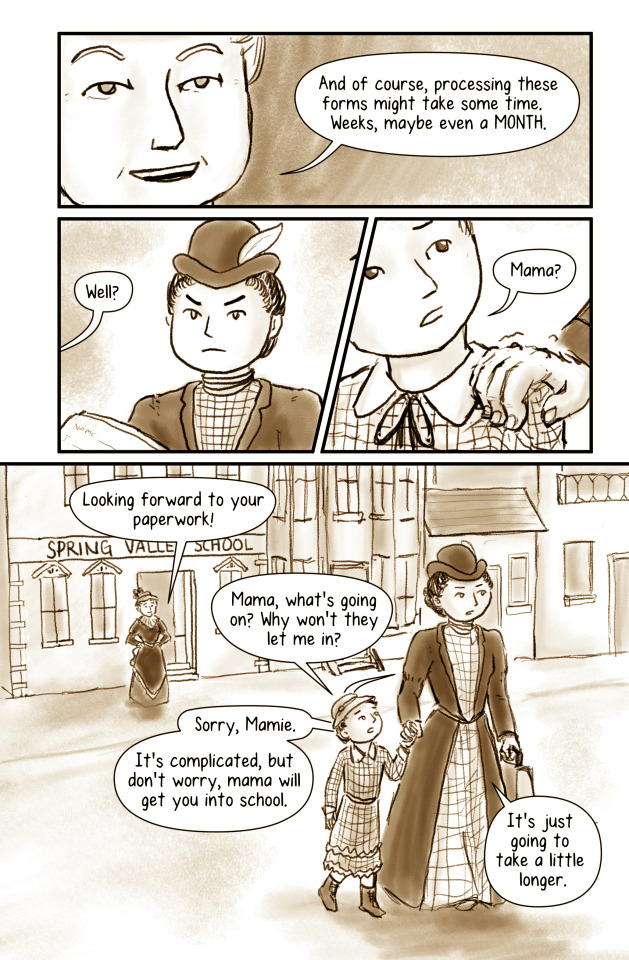
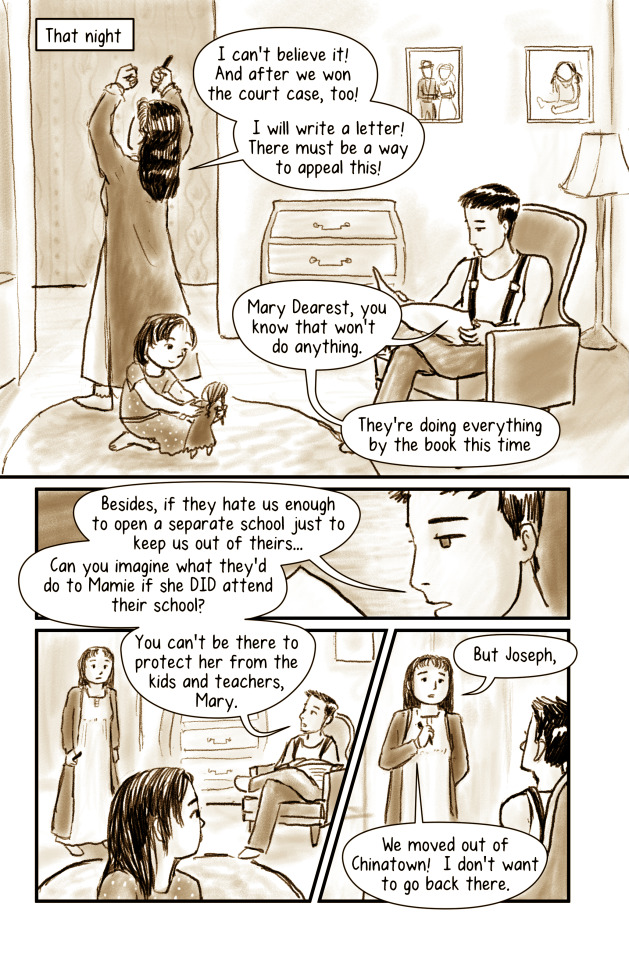
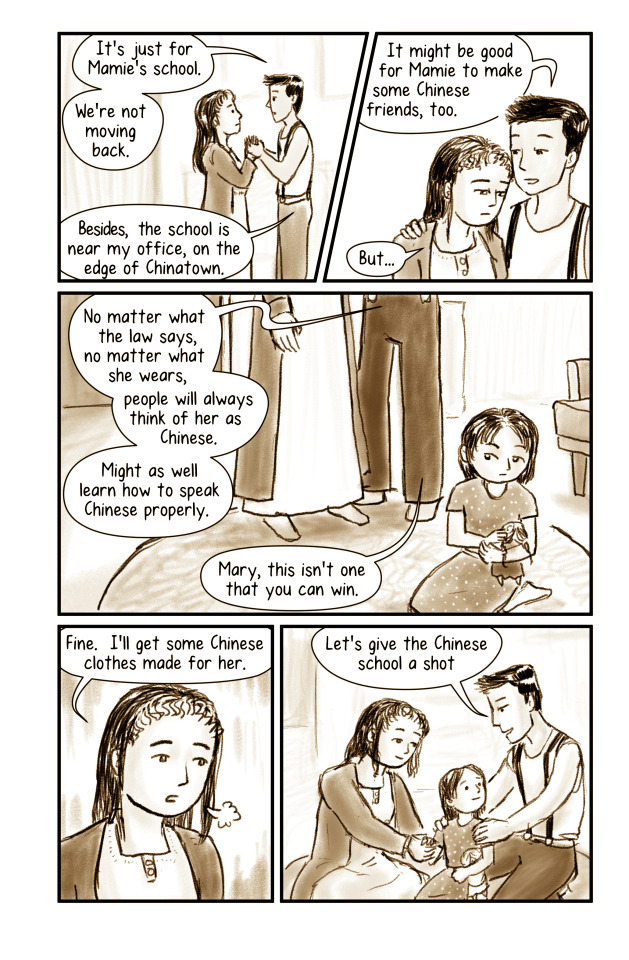
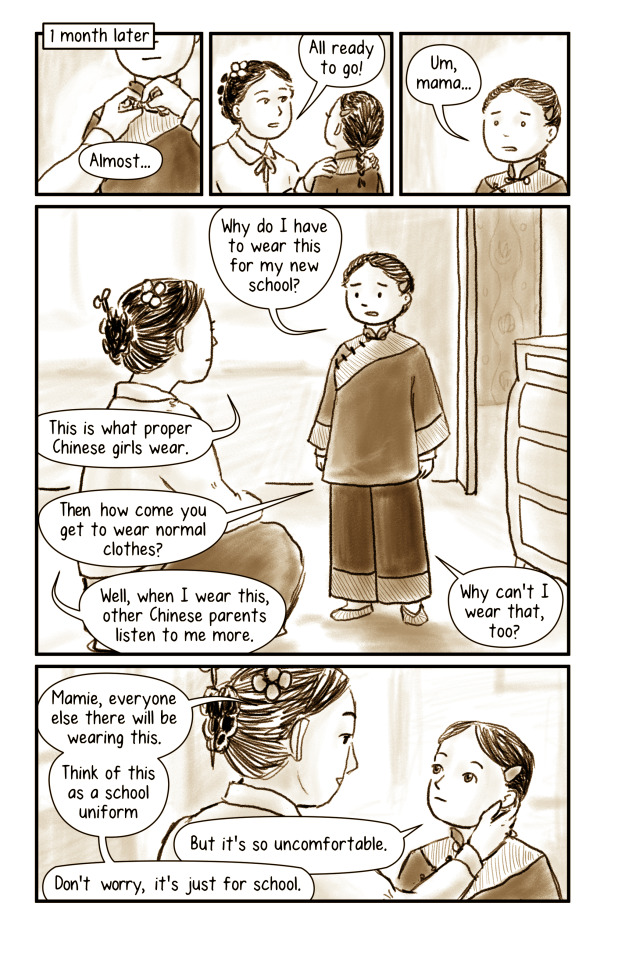
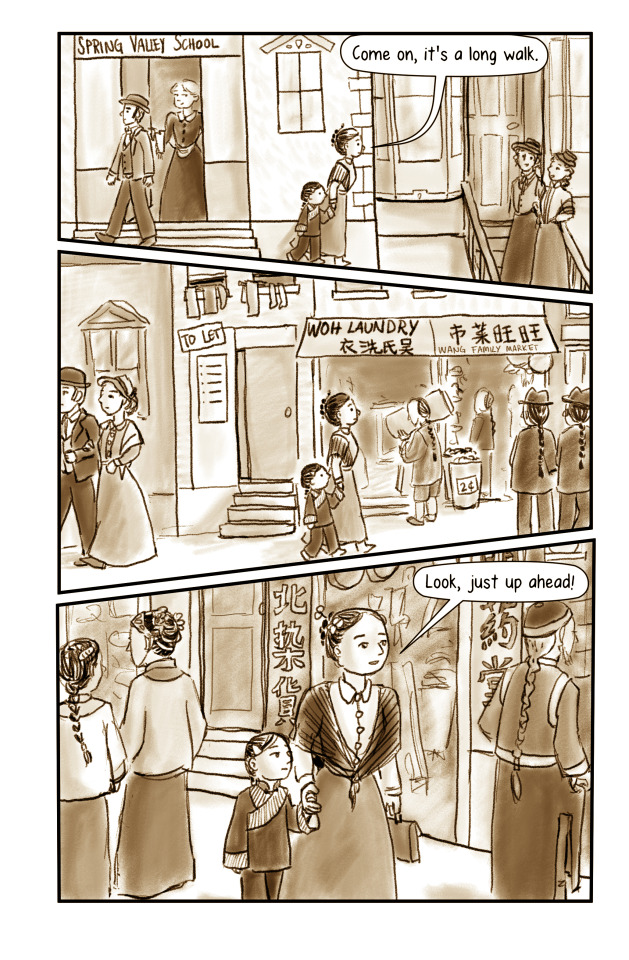
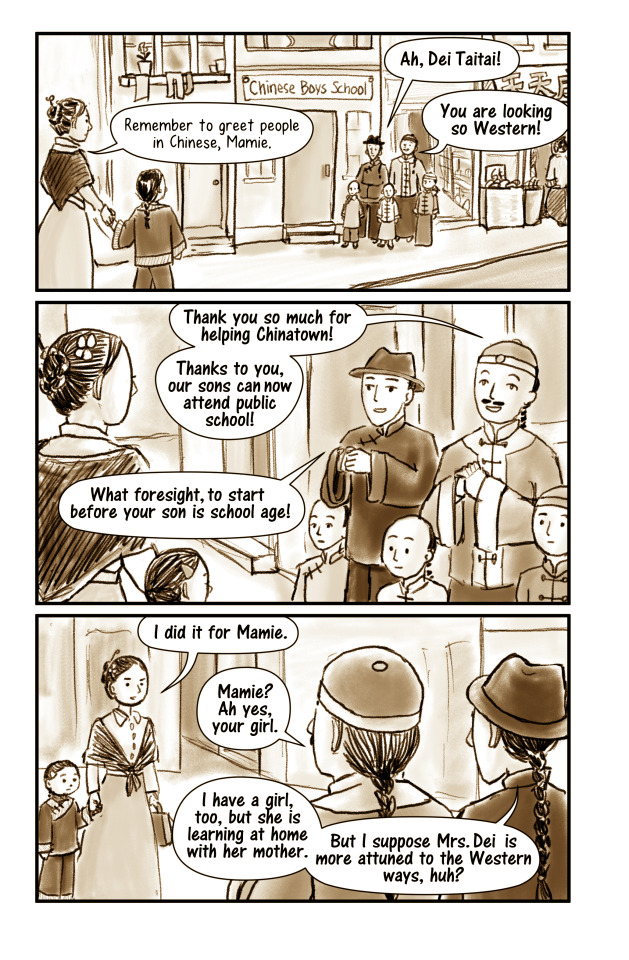
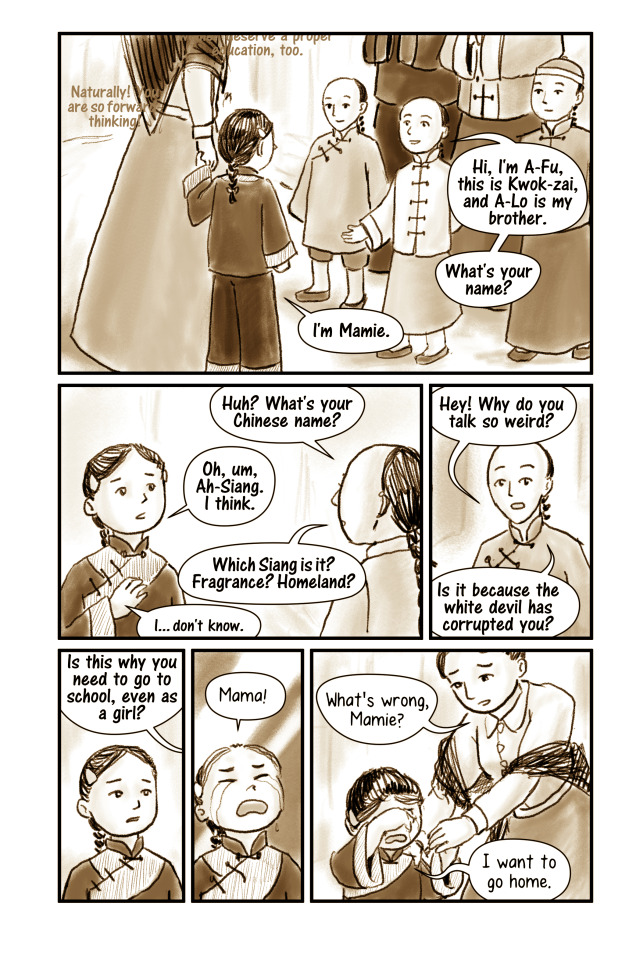
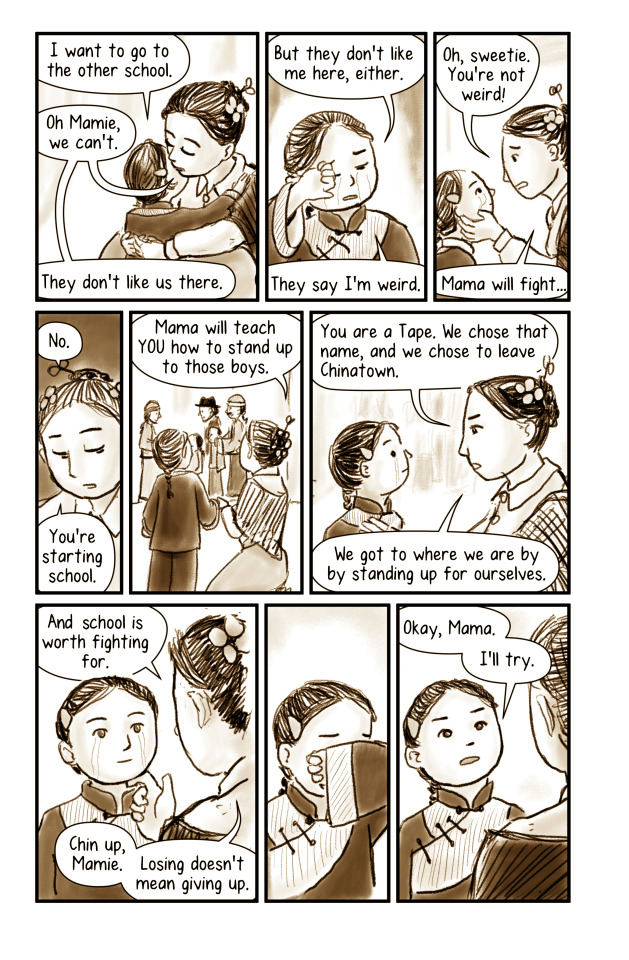

Historical Notes
Mary and Joseph Tape were not born in America, but their names and identities were very much formed in America. Joseph Tape was born Jeu Dip in Guangdong, China, immigrated the America when he was twelve, and spent his teenage years working as a house servant in an Irish household. Mary arrived in America at the age of eleven, and was found and raised as Mary McGladery in a Protestant orphanage as the only Chinese child amongst ~80 children. Both Mary and Jeu spent their formative years amongst White Christian families, so when Jeu Dip and Mary married in 1875, little wonder that Jeu picked the English name of Joseph Tape -- Joseph to match with Mary, and the German last name Tape as a nod to his former name of Dip.
The Tape family lived about 14 blocks outside of Chinatown, in a primarily white neighborhood. They dressed in Western clothing, spoke English at home, and Mamie grew up playing with non-Chinese kids. Naturally, they wanted their children to attend the local elementary school, a mere 3 blocks from their home. The principal, Ms. Hurley, denied her entrance, claiming that she was “filthy and diseased.” At the time, there was no public school option for Chinese children -- the 1870 state law stipulated separate schools for “African and Indian children” only, not Chinese. The Tape family, with the help of the Chinese Six Companies, their church, and the Chinese consulate, decided to sue, claiming that the 1880 California school code guaranteed everyone a right to public education and that this was a violation of the 14th Amendment.
They won.
But this was 1885, three years after the passage of the Chinese Exclusion Act and six years before Plessy v Ferguson. Regardless of what the California Supreme Court might decide, public sentiment was on the side of the San Francisco school district. Determined to keep out this “invasion of Mongol barbarism”, the California State Legislature passed a law permitting separate schools for Chinese children, which then allowed Principal Hurley to reject Mamie Tape once more.
While Mamie was rejected from the Spring Valley Elementary School for being Chinese, she also had a hard time fitting in to the Chinese public school. The Chinese merchants saw Western education as something primarily for boys. (Their girl children learned from their mothers at home.) Mamie, a girl dressed in Western clothes, would have stood out like a sore thumb. The final panel of the comic was based on a photo from three years later, and even then, Mamie was the only girl.

Places where I fudged the history: Frank, Mamie’s younger brother, was actually six years old and should have been more present in the comic, but I wante to keep the focus on Mamie and Mary. Also, Mamie had actually shown up to her first day of school in Western clothes. An earlier draft of the comic had a separate arc involving Mamie feeling rejected at school and Mary buying her some Chinese clothes, but that got too long and complicated.
Much of this was drawn from Mae Ngai’s book about the Tape family and their experiences as 2nd and 3rd generation Chinese Americans, titled “The Lucky Ones.”
----------
Here is Mary Tape's letter to the San Francisco School Board, 1885:
1769 Green Street. San Francisco, April 8, 1885. To the Board of Education - Dear Sirs: I see that you are going to make all sorts of excuses to keep my child out off the Public schools. Dear sirs, Will you please to tell me! Is it a disgrace to be Born a Chinese? Didn’t God make us all!!! What right have you to bar my children out of the school because she is a chinese Decend. They is no other worldly reason that you could keep her out, except that. I suppose, you all goes to churches on Sundays! Do you call that a Christian act to compell my little children to go so far to a school that is made in purpose for them. My children don’t dress like the other Chinese. They look just as phunny amongst them as the Chinese dress in Chinese look amongst you Caucasians. Besides, if I had any wish to send them to a chinese school I could have sent them two years ago without going to all this trouble. You have expended a lot of the Public money foolishly, all because ofa one poor little Child. Her playmates is all Caucasians ever since she could toddle around. If she is good enough to play with them! Then is she not good enough to be in the same room and studie with them? You had better come and see for yourselves. See if the Tape’s is not same as other Caucasians, except in features. It seems no matter how a Chinese may live and dress so long as you know they Chinese. Then they are hated as one. There is not any right or justice for them. You have seen my husband and child. You told him it wasn’t Mamie Tape you object to. If it were not Mamie Tape you object to, then why didn’t you let her attend the school nearest her home! Instead of first making one pre tense Then another pretense of some kind to keep her out? It seems to me Mr. Moulder has a grudge against this Eight-year-old Mamie Tape. I know they is no other child I mean Chinese child! care to go to your public Chinese school. May you Mr. Moulder, never be persecuted like the way you have persecuted little Mamie Tape. Mamie Tape will never attend any of the Chinese schools of your making! Never!!! I will let the world see sir What justice there is When it is govern by the Race prejudice men! Just because she is of the Chinese decend, not because she don’t dress like you because she does. Just because she is descended of Chinese parents I guess she is more of a American then a good many of you that is going to prewent her being Educated. Mrs. M. Tape
#original comic#chinese american history#legal history#turns out there's a lot of chinese american court cases#that i have a lot of feelings about#my comic#mine
2K notes
·
View notes
Text
Alastor - Historical Trivia And Headcanons

Alastor was a mixed-race Creole man living in New Orleans, and was in his 30's/40's when he died in 1933. We don't know much else about him, but historical context can provide us with possible additional details:
The population of New Orleans in 1930 was 458,762, more than it is now. 27.2% of the people were black, 3.1% were foreign-born, and roughly half of America's bipoc population was unemployed thanks to the Great Depression. New Orleans' original Francophonication was still strong, and it was common to run into locals who only spoke French dialects (Cajun French, Louisiana Creole). The city has had a huge Chinatown, a small Little Italy, and multiple other districts known for their immigrant African/colonized French cultures.
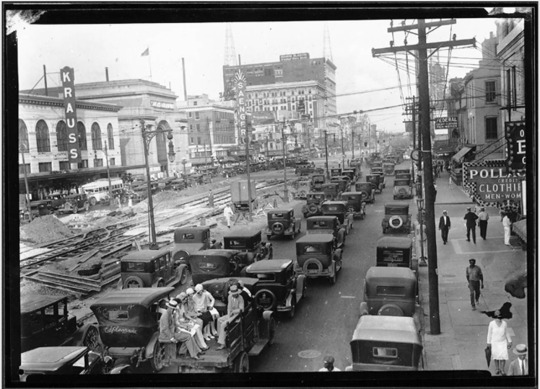
The Jim Crow laws were heavily enforced, as was the 'One Drop' rule. If Alastor was a mixed race black man, he would not have been able to attend a white school, use the same public transport, and would have shopped at black-local stores and restaurants under threat of violence. If he was mixed with any other race, some Jim Crow laws didn't apply, but state or city laws might specify differently.
Just because Alastor wears a suit, it doesn't mean he was rich in life. Radio personalities often didn't earn a fortune. Unless he owned his own broadcast, he was paid by a private company for long shifts of hosting music, news, and radio plays. In 1930, 40% of households owned at least one radio, which means that a popular radio host would have been easily recognized.
If he was in his late 30's in 1933, he might have fought in WW1, so long as he was over the age of 21. Some cities gave veterans small benefits, or encouraged the community to give them jobs. This often did not include veterans of color.
New Orleans was famous for being one of the least Christian cities in America, thanks to its unique immigrant and slave population. Haitian-based faiths and practices (such as voudo), indigenous cultures, Asian Buddhism, and atheism were common. But Christianity was still the official, law-enforced religion. Schooling involved reading the Bible, laws were sworn to Jesus, etc.
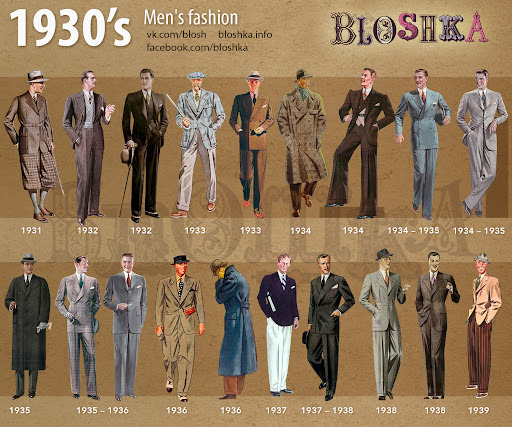
Alastor's outfit in Hazbin Hotel isn't very accurate to real-life American men's fashions of the time. Back then, deviating from the norm with the smallest detail would have stuck out like a sore thumb - like his white-lined lapels. Men always wore a hat. They were allowed to go without a waistcoat, but not a jacket. Belts were becoming more popular than suspenders. The silhouette was bulkier than the slimmer, Italian cuts of our modern times, especially the pants. Hair was kept short, and oiled down in a side part. Americans preferred the clean shaven look. Ties were essential unless you were a blue-collar laborer. Colors were almost universally muted neutral tones for everyday wear. The most colorful textiles for men were sporting outfits, like a tennis jacket.
If Alastor was a middle-class single man, he likely would have lived in an inner-city apartment, in an ethnic neighborhood. He probably didn't own a car, and took public transit like the streetcars. If he owned a house, it would likely have been an inheritance, and even the more opulent houses of the time would have looked small and plain to our eyes.
Because of the Great Depression, unmarried men were becoming the norm, rather than the exception. Men of the community who were sought after but remained single were suspect to gossip, but less ire than you might think; in the '30s, American queer culture was going through a very sharp revival, escaping the rigid Victorian era and before the puritan 40's/50's. But as a mixed-race man, it may have been illegal for a white woman to marry him, as the Jim Crow laws forbade the marriage of white people and Black/Asian people.
A middle class city household would have had electricity, gas heating, indoor plumbing, but may not have had running taps or a gas stove. Even with decent means, Alastor might have been using a potbelly woodburning stove, a dry sink/washbasin, wooden bathtub, and did his own laundry instead of sending it to the neighborhood laundresses. He may or may not have bothered with an icebox. Fresh groceries needed to be cooked and eaten soon, as things like pasteurized milk or store refrigeration wasn't a thing.
If he had enough money, then he almost certainly hired maids or other servants. Whether the maid came over just once a week, or did the shopping and laundry every other day, hired help was much more common back then, especially if he had no wife.
The most popular musicians in 1933 were Bing Crosby, George Olsen, and Leo Reisman. As you might have noticed, it was trendy for the lead singer to be backed by an orchestra, not a 'band' of just four other people like today. The most popular radio shows were Dick Tracy, Sherlock Holmes, and Doc Savage. They were recordings the radio station would buy and then broadcast, or sometimes the actors were live on the air. The radio host was usually not the journalist - the production team was responsible for writing his script.
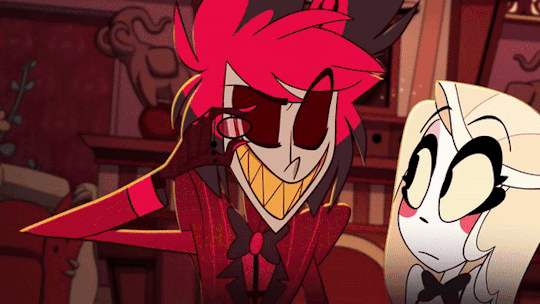
#alastor#alastor the radio demon#hazbin hotel#hazbin alastor#alastor headcanons#hazbin hotel headcanon
117 notes
·
View notes
Text
The Blossom surrounded by Fire - Ch. 1 (Warrior AU- HBO MAX)
Amaka, is an African American woman with cosmetically altered ears due to her past ownership. Her journey has led her to Chinatown in San Francisco where she is now under the guardianship of Wang Chao. As Amaka tries to remain invisible, helping any ill residents with her healing knowledge, she slowly becomes drawn in to the dangerous world of the tongs. Seeing as she is a black face in a town of yellow, she is powerless to the demands of tong leaders and their lieutenants. They use her for their own gain, however calm and collective Long Zii lieutenant, Li Yong, sees more than just a body, and sees into her heart. But how can he claim his blossom when she is surrounded by nothing but fire?
MDNI, +18 , smut, SA, 1800 period story, racial slurs, etc.

-------------------------------------
I never really thought about my future, because for the negro the future was death if you came across the wrong person. Everyone is the wrong person. I was constantly waiting for death to come either by sickness, hanging, or something more sinister.
I didn’t know where my path was going to take me, but one thing for sure, it was going to be one hell of a crazy ride on my way to hell that was for sure.
My eyes slowly crept open as I could smell fish. I was on my back which brought me some comfort. Because of my ears, I could never stay on my side for too long. I sat up slowly and gently scratched my curly mane. I knew he wouldn’t allow me to sleep in, not while there was work to be done. I removed the blankets from my body and got up. Sliding the door open, I was looking at the nicely dressed back of Wang Chao.
Upon my unexpected arrival to San Francisco, our paths crossed and although we didn’t trust each other then, my ability to speak Cantonese and other languages made me useful to him as a translator for business with others. Also my willingness to help the sick with my knowledge of medicine. I entered the room and moved over to him giving a soft smile as he glanced at me.
“Good morning.” he said with a gentle smile, and I leaned forward and kissed his cheek.
“Good morning.” I said and he immediately raised a bowl of fish and rice. I looked up at him and nodded my thanks and took it.
“How did you sleep last night?” I asked picking up a pair of chop sticks and using it to eat. He sighed now raising his own bowl to eat.
“As good as any with one eye open as usual. How about you?” he asked. I shrugged some.
“I slept okay… I am pretty sure I lied on my side for a bit too long.” I replied. Chao nodded observing the side of my head. Slowly he raised his hand to move the side of my hair off my shoulder. I was still as he exposed my pointed ear.
“They’re still sensitive.” he noted. I nodded.
“They may be like this forever. I don’t know what he was thinking when he did this.” I replied my mind drifting back to that horrible night. I remember a violent storm had hit and it was the perfect time to do what he did. No one could hear my screams of sheer agony. I wanted to die that night. I hadn’t realized I was looking out into the empty space beside my guardian, until his hand gently came to my cheek.
“Hey. Don’t do that to yourself. Don’t put yourself back in that state of pain. You are safe here with me.” he said. I couldn’t help but grin.
“You are a black-market salesman who also sells men that come off the boats to different tongs. How am I safe?” I teased. He gave a mild grimace.
“Well, you know how to ruin a mood.” he said, and I chuckled some before looking down some in thought.
“People are starting to talk. They know we are… associates.” I replied. He nodded.
“Well, what do you expect, a colored woman with pointy ears is walking about Chinatown without a care in the world.” he said. I gave him a stunned look.
“Without a care in the world? Hardly. That’s a duck’s privilege.” I reminded and he nodded bringing a small cup to his lips.
“Very much so.” he said swallowing and then looking down at me. “Since everyone is whispering about you, those whispers have been slipping their way into different tongs.”
I could hear the warning in his voice.
“Which tongs?” I asked.
“All of them. At first no one batted an eye, but now that you’ve been helping the Chinese with their fevers and other sicknesses, it’s only a matter of time before their leaders call on you for services.” he said. Hop Wei, Long Zii, Fung Hai, Suey Sing… violent gangs who are in the opium trade. I had a lot to learn once Chao decided to take me in. He only told me the names of the leaders, but I had never seen them face to face. When I would walk about with him, he shielded me from the eyes of those he knew were dangerous.
I didn’t care about the gangs. I just wanted to help those who needed it. I have seen a lot over the years and one thing I knew: if you are not white, you do not matter to the world. With what I knew, I wanted to help people anyway I could.
Chao with his connections, delivered to me the ingredients and supplies I needed to create my herbs and medicines.
“Then let them call on me. If someone is sick, I will help them.” I replied turning from them. However, his hand caught my forearm firmly and I looked up at him. The seriousness in his eyes made me somewhat worried.
“Amaka… the reason why I am an independent contractor is because being alone keeps me safe. My loyalties are to myself and helps me survive. You, being a good healer, is a good skill. It will help you survive. But sadly, you not being Chinese means you can easily be discarded and forgotten in this town if you catch the attention of the wrong people.” he said. I winced at his words and looked away some.
“It almost saddens me to know I don’t have your loyalty. But I guess after everything you have done for me so far; I will only take what I can get.” I said softly. He shook his head and planned to say something, even going so far as to put his hand on my cheek, but I shook my head. “The day is starting. We both have jobs to do.”
He sighed and nodded.
“You are right. I will open the shop.” he said. I nodded and sat my finished bowl of food down on the counter.
“I will get dressed. I need to check on a few families.” I replied and we both parted. I cleaned my face and pulled the top half of my hair back and pinned it down with a large black clip that Chao had gotten for me. The bottom half remained down and covered my ears. I’ve been called a demon before, and my ears have put me in danger many times before. It was best to keep them covered. I wore a faded white dress with red flowers over the chest hem. It was tight around the bust area, as my bust was big, but I wouldn’t complain. It wasn’t anything too nice, but showed I wasn’t a threat either. Chao had found many dresses for me to wear upon him taking me in. He even gave me a small satchel to carry my medicine and journal in. I wrote down symptoms and medicines to help said symptoms. I slid on a pair of black boots and headed out through the market area where Chao had most of his weapons. When he saw me approach, he looked me over before looking confused.
“You’re going to wear that dress? That’s your nice gown I got you for when we go to meet Ah Toy tonight.” he said. This woman is a brothel owner who Chao had spoken to a lot apparently. He wanted me to meet her as insurance in case anything happened to him, then I could go to her for help. However, this is the first time I am hearing that I was to meet her tonight.
“You tell me this now?” I asked. He scoffed.
“It’s not like you had plans tonight.” he said. Touché. Chao had the luxury of walking about Chinatown without being bothered. I did not have this luxury unless I was with him and that was very rare since he was usually doing business with the tongs. If he had a new customer who spoke a different language then I would help, but other than that and helping those who sought me out for my help, I remained inside, hidden away as to not make anyone uncomfortable.
“Do you really think this dress will help me blend in at a brothel?” I asked. He looked me over.
“In a room full of yellow, you will always stand out.” he said. I couldn’t help but touch my cheek at his words knowing them to be true. “But now that I think about it, you can’t wear that dress either. If you’re going to be at my side, then you’ll need something far better.”
I smiled and nodded.
“You’re the boss.” I replied stepping closer to him and pecking his lips. “I will be quick.” He nodded.
“You got your knife?” he asked, and I reached into my back and pulled out the black handled blade and showed it to him.
“I have my knife.” I replied. He nodded with approval, moving to hand me the brown hooded topcoat. I began to put it on and place the hood over my head. Slowly he took my hands in his and I could see the look of worry in his dark eyes.
“Please be careful.” he said. I smiled and nodded before moving through the front of the store where multiple chickens cawed loudly and out into the town I went.
#warrior hbo max#warrior#ambw smut#blackfemaleoc#Bolo warrior#Bolo#Rich Ting#Zing#Dustin Nguyen#Li Yong#Joe Taslim#Ah sahm#Mai Ling#Ah Toy#Nellie Davenport#Bill O'Hara#Penny Blake#Wang Chao#young jun#father jun#Tongs#Chinese Gangs#Industrial era#hong#Long Zii#Dan Leary#ambw#ambw fic
8 notes
·
View notes
Text



Exploring Manhattan: The Heart of New York City
Manhattan, the vibrant heart of New York City, is a place where history, art, culture, and commerce converge. With its iconic skyline, diverse neighborhoods, and endless entertainment options, Manhattan offers an experience like no other. Whether you’re visiting for the first time or rediscovering the city as a local, here’s everything you need to know about exploring Manhattan.
1. Iconic Landmarks
No visit to Manhattan is complete without exploring its famous landmarks. The Statue of Liberty stands proudly in New York Harbor, symbolizing freedom and hope. Nearby, Ellis Island shares the stories of millions of immigrants who helped shape the city’s history. Another must-see is the Empire State Building, offering breathtaking panoramic views of the skyline from its observation deck.
Other landmarks include Times Square, known as "The Crossroads of the World," where bright lights and billboards dazzle visitors day and night. Central Park, an oasis in the city's midst, provides a natural escape with walking trails, ponds, and beautiful scenery. For art lovers, the Museum of Modern Art (MoMA) and the Metropolitan Museum of Art are must-visit destinations.
2. Diverse Neighborhoods
Each neighborhood in Manhattan has a unique personality, offering something for everyone. SoHo, known for its cobblestone streets and trendy boutiques, is a haven for art enthusiasts and fashionistas. The Lower East Side showcases the city’s immigrant history with vibrant eateries and cultural sites. For a taste of luxury, visit the Upper East Side, home to upscale shops, fine dining, and classic brownstones.
Head to Greenwich Village for a bohemian vibe with live music venues, quirky coffee shops, and the birthplace of the Beat movement. Meanwhile, Harlem offers rich African American culture, from soul food to jazz clubs and historic churches. Chinatown and Little Italy are other highlights, each offering unique flavors, cultural landmarks, and annual festivals.
3. Entertainment and Nightlife
Manhattan is famous for its Broadway district, where world-class musicals and plays entertain millions. Be sure to catch a show in one of the historic theaters, or, for a unique experience, see an off-Broadway production. The nightlife scene is also thriving, with rooftop bars offering stunning skyline views, jazz clubs in the West Village, and dance clubs in Chelsea.
If you prefer a more relaxed evening, consider a dinner cruise along the Hudson River. You’ll enjoy beautiful views of Manhattan’s illuminated skyline, including landmarks like the One World Trade Center, Chrysler Building, and Brooklyn Bridge.
4. Foodie’s Paradise
Manhattan is a culinary haven, offering everything from food trucks to Michelin-starred restaurants. For street food, try a New York-style hot dog, a classic slice of pizza, or a bagel with lox and cream cheese. Food halls like Chelsea Market and the Essex Market offer international cuisine, artisanal groceries, and unique dining experiences.
If you’re in the mood for fine dining, Manhattan boasts some of the world’s best restaurants. Jean-Georges, Eleven Madison Park, and Nobu offer exceptional experiences for food lovers. And don’t forget the borough's dessert scene: Magnolia Bakery’s cupcakes and Levain Bakery’s cookies are must-tries.
5. Shopping Extravaganza
For shopping, Fifth Avenue is a dream destination, offering high-end brands like Gucci, Prada, and Louis Vuitton. For unique finds, head to the markets in Hell’s Kitchen or the boutiques in NoLIta. And if you’re looking for budget-friendly options, the Garment District has plenty of sample sales and outlet stores.
Manhattan truly has it all—from world-renowned landmarks and diverse neighborhoods to mouth-watering cuisine and unparalleled entertainment. Whether you’re strolling through Central Park, dining in Little Italy, or exploring the art galleries in Chelsea, Manhattan will capture your heart and inspire memories that last a lifetime.
4 notes
·
View notes
Note
You know the whole 'Hi we have the cure for cancer but we're not going to share it with the world' awful, literally. Mythos thing about Wakanda made notice something
The cure was cancer was definitely not a silver age thing
It stated Kirby made Wakanda (though their advance technology was a later on addition) because he was tired of poverty porn Africa
And Wakanda xenophobia was acknowledged, because I learn there a page in a silver age comic where an African American character went “what’s up brother!” to a Wakandan
And the Wakandan him a “mute”
Now here my theory because when your…ancestors went to Europe for the world wars
Actually I think a lot of white Americans (especially poor ones) had a fetishized view of Europe. And they probably had they until WW1 where many had a one in a lifetime experience to meet Europeans
Then the Europeans immediately pointed out that Americans are foreign to Europe as a Chinese person.
Which definitely broke the illusion of Europe and lead to our modern American identity
Make sense?
So sliver writers probably took that account with doing black panther Mythos
Now the cure for cancer thing, oh I got my suspicions but I think older comic readers can help
But in the 00’s there was two black writers one named Houdini and the other Christopher Priest
Now I vauge on Houdini, but him and priest had that “WE WUZ KINGS” mindset
So they pushed the advance Wakanda shit…while saying that it’s a okay that Wakanda is xenophobic as fuck.
Actually I’m going to do a part to, but I notice something with black Americans writers when they get their hands on stuff.
Oh btw for Priest, well MCU Wakanda was heavily based off his run….
But Priest and the creator of boondocks had a falling out
To the point McGrunder took a piss out of him in a boondocks episode
Oh, priest had black panther beat silver surfer by using a wrestling move….so you can guess his mindset….Im not better with some crazy shit he tried to pull at dc in the 2010’s…no sir ree…
Actually I think a lot of white Americans (especially poor ones) had a fetishized view of Europe. And they probably had they until WW1 where many had a one in a lifetime experience to meet Europeans Then the Europeans immediately pointed out that Americans are foreign to Europe as a Chinese person. Which definitely broke the illusion of Europe and lead to our modern American identity
Never thought about it that way, though there is a lot of genetic memory in Americans we have tried to keep where we came from with ourselves to a degree, or at least some of us do.
Go find the local Greek community or little Saigon, Chinatown, Little Italy, and so on.
(relevant tangent time)
Guy named Andrew Doro (looked it up) made a splash several years back by chronicling his journey to eat food from every country in the world without leaving NYC, got his blog, and IG, looks like he's still going most recent post is from 5 days ago.
Older interview here
Not something you can do in Billings Montana but it's a cool project.
But ya some of us have done our best to keep the "old world" alive in our new home, you also get the families that came over and assimilated themselves forcibly.
Or you get mutts like me who's family roots go back before the revolution in some parts and while I know what my DNA says I also know that I'm American and not Irish or German.
Probably a good deal of what you were talking about going on in the aftermath of WW1 and 2 for sure, GI's staged in England before D-Day which was close enough to the US to not throw them but I'm sure folks had some culture shocks seeing the "old world" first hand.
We also can't forget
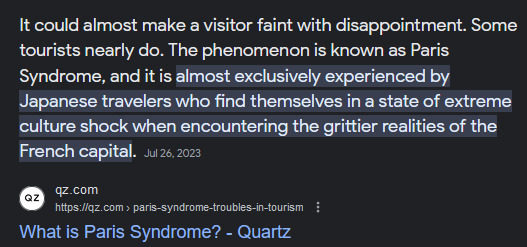
I imagine some weebs have a similar experience.
As for the comic stuff I am not well enough versed in those to even say which is golden or silver age, I just recall that there was a deal with them holding on to the cure for cancer.
Mostly brought up when you'd get people talking about how great Wakanda was and their only experience was MCU, which is lots of people for lots of the characters in the MCU.
Had someone spouting off that Captain America wouldn't use guns, just his shield like steven universe, double dumb because he was shown using guns in The First Avenger.
But I'm sure I have a fair number of followers that will have the information on that and hopefully one or more of them adds it here or if they want to send it as a ask that works too.
Honestly my biggest issue with MCU BP was people thinking that either Wakanda was real or it's what Africa would have been like if not for colonialism.
Which both things are insane just for different reasons.
6 notes
·
View notes
Text



Has anyone else noticed an uptick in queer authors of color winning prestigious literary awards lately? Not just the Lambda Literary Awards, but National Book Awards and others that aren't queer-specific?
Here are my thoughts on some award-winning books by queer people of color I have read in the last few months:
The Prophets by Robert Jones Jr. is devastating novel about a Southern plantation where two enslaved men have found comfort in each other. Thought their romantic and sexual relationship is what makes this book "novel," it's about so much more than that. It's about the role of women, the role of ancestors, the importance of the parts of African cultures that were retained despite the Middle Passage... it's about power: racial, sexual, and economic. Above all, it's about what it means to be UNfree. Things you might like about this book: witchcraft and magical realism. Things you might not like: many, many instances of sexual (and physical) violence.
The Lesbiana's Guide to Catholic School by Sonora Reyes. I loved this book so much, I don't want to spoil anything about it for you. Just read it. It's very funny.
Last Night at the Telegraph Club by Malinda Lo. Another baby-dyke love story (like The Lesbiana's Guide), this time set in SF Chinatown in the 1950s. Touches on the bar raids/lesbian bar culture, the Red Scare, and the threat of deportation that Chinese immigrants lived under as well as the racialized and gendered expectations of young Chinese American women.
All This Could Be Yours by Sarah Thankam Mathews. About a young Indian lesbian working a hellish entry level corporate job in Milwaukee after college. Much of this will be relatable to anyone who has survived their 20s or the isolation of moving alone to a new city. The unexpected aspect is how the book deals with trauma, illustrating how past sexual violence can effect one's ability to form new intimate relationships. The protagonist is flawed, but she's doing her best, under a lot of familial pressure, a very long way from home, which I think makes her sympathetic enough to follow throughout her many bad decisions.
The Town of Babylon by Alejandro Varela. I really loved this book. It's ostensibly about a man reconnecting with an old flame (despite being married) while visiting his hometown to take care of his ailing father. But again, it's about so much more: it's about immigration, about being the first to racially integrate a neighborhood and the hostility that comes with it, about the health impacts of living under the stress of racism and poverty. I was truly impressed by the scope of this novel and the way the author can reduce complicated phenomenon into simple lists demonstrating relationships between cause and effect. Highly recommend.
QPOC books on my "to be read" shelf:
Any Other City by Hazel Jane Plante
Stay True by Hua Hsu
You Exist Too Much by Zaina Arafat
Hijab Butch Blues by Lamya H
Of the books by queer people of color you've read recently, which are your faves?
6 notes
·
View notes
Text
It’s really dumb how people argue that the lower scores of black people on intelligence tests are somehow proof of hereditary inferiority. Without getting into the weeds of what those tests really measure, or how well, Subsaharan Africans invented iron metallurgy at the same time as Europe (800 years before China) but without bronze in between. West Africans were at the “Aztec codex” phase of inventing writing—independently—when Arabs and Europeans showed up with their own full-fledged systems (which neither Arabs nor Europeans invented) and rendered it moot. No but clearly people who did those things, are innately stupid. Right?
Or, just maybe, having the highest rate of being raised by single mothers, and hearing, let alone reading, tens or hundreds of thousands fewer words during childhood, has known effects on cognitive development. Never mind that before the Great Society imploded the black family, the gap between white and black performance on the tests was rapidly closing, as blacks experienced the “average score increases every few years” phenomenon faster than whites—far faster than genetic changes could account for. (Also fun fact, Asian-Americans do not score higher than whites, except in certain Chinatowns that use outdated tests. On up-to-date ones they actually score several points lower than whites—which could just be the handicap introduced by culturally-skewed tests, admittedly—and cultural values about hard work and thinking systematically make up the difference.)
What you call intelligence is, at least in large part (there’s probably some heredity involved), a matter of intellectual stimulation in childhood. Read to your kids, and talk to them—it helps to be married, so your spouse can read and talk to them when you can’t.
11 notes
·
View notes
Text
"Working your way up the system doesn't mean you beat the system. It strengthens it. It's what the system depends on."
I chose this quote from Charles Yu's book, Interior Chinatown, which I recently read this summer, because it relates closely to Adichie's Jumping Monkey Hill. In Yu's story, Willis Wu fights upstream to graduate from Generic Asian Man to Kung Fu Guy in the tv industry, only to find that he is just as exploited and tokenized in this 'higher' role. It reminds me of how the Ugandan man in Jumping Monkey Hill worked his way up to become a leader of the writer's workshop, but he seemed to "pull the latter up with him" by not showing the other writers the same respect he showed to Edward. Instead of using his position to help argue for his fellow writers from the African continent and bridge the gap between them and their publisher, he typically stayed on Edward's side of any arguments, adding further to the power imbalance. Additionally, Interior Chinatown is an excellent example of how single-stories of any people group can be dangerous. In this novel, Americans of Asian descent are pinpointed into specific roles because of the stereotypical single story that has been painted about them.
5 notes
·
View notes
Text

An illustration from the November 20, 1880, issue of Frank Leslie's Illustrated Newspaper depicts an anti-Chinese riot in Denver, Colorado. Violence against Chinese immigrants was widespread in the American West. Courtesy of The Chinese American Museum/Dylan and Phoenix Wong
Race in America: The Bloody History of Anti-Asian Violence in The West
One of the Largest Mass Lynchings in the United States Targeted Chinese Immigrants in Los Angeles.
— By Kevin Waite | Published May 10, 2021
This year marks the 150th anniversary of one of the largest mass lynchings in American history. The carnage erupted in Los Angeles on October 24, 1871, when a frenzied mob of 500 people stormed into the city’s Chinese quarter. Some victims were shot and stabbed; others were hanged from makeshift gallows. By the end of the night, 19 mangled bodies lay in the streets of Los Angeles.
Lynching is a term most often associated with violence against African Americans in the post-Civil War South. But racial hatred has never been quarantined to one American region or confined to a single ethnic group. In Los Angeles in 1871, the victims were Chinese immigrants. Their deaths were part of a wave of anti-Asian violence that swept across the 19th-century American West—and reverberates to this day.


In the early days of Chinese immigration, many new arrivals performed hard manual labor, often for the railroads or as prospectors. Photograph By Photo By George Rinhart, Corbis/Getty Images (Left) and Photograph Via Alamy (Right)
Chinese immigrants became the targets of abuse almost as soon as they set foot on American soil, beginning in 1850 with the California Gold Rush. White prospectors routinely drove Chinese miners from their claims, while state lawmakers slapped them with an onerous foreign miners’ tax. Along with Black Americans and Native Americans, they were barred from testifying against whites in California’s courts. As a result, assaults on Chinese people in California generally went unpunished.
A perceived labor threat lay at the root of this Sinophobia. By 1870, Chinese immigrants accounted for roughly 10 percent of California’s population and a full quarter of the workforce in the state. Wherever Chinese immigrants congregated in large numbers, white workers saw a risk to their livelihoods. The threat posed by Chinese immigration never represented the existential threat to white employment that some agitators claimed. Nevertheless, they mobilized against employers, including railroad corporations and wealthy ranchers, who had Chinese immigrants on their payrolls.

Created in 1847, the earliest known drawing of Los Angeles comes from the brief period in the city's history when there weren't Chinese residents. The first recorded Chinese immigrant to Los Angeles arrived in 1852.

In 1882, more than a decade after the attack, Calle de Los Negros—the heart of Los Angeles's original Chinatown and the site of the massacre—is bustling. Photograph Via USC Digital Library, California Historical Society Collection
The campaigns against Chinese immigrants were well organized. In the immediate post-Civil War years, so-called anti-coolie clubs arose. The Central Pacific Anti-Coolie Association, among others, advocated for a ban on Chinese immigration and even defended white vigilantes. In 1867, a mob of white laborers drove Chinese laborers from their San Francisco worksite, injuring 12 and killing one. The Anti-Coolie Association rallied to the mob’s defense and won the release of all 10 perpetrators. This would become a recurring theme: injury and death for Chinese immigrants, exoneration for their assailants.
In the Reconstruction-era South, the Ku Klux Klan targeted African Americans and their white allies; in the West, Klansmen assaulted the Chinese. I’ve uncovered more than a dozen attacks on Chinese workers between 1868 and 1870 attributed to the KKK in California, as well as a smaller number in Utah and Oregon.
Klan activity in California ranged from violent threats to assault to arson. In the spring of 1868, white rioters raided a series of ranches in Northern California, savagely beating the Chinese workers there. When a Methodist minister opened a Sunday school for Chinese immigrants in 1869, vigilantes burned down his church and threatened his life. Klan-affiliated arsonists torched a second church, this one in Sacramento, for the sin of serving the Chinese community. They also burned down a brandy distillery near San Jose that employed Chinese workers.

In the South, the Ku Klux Klan targeted African Americans. In the West, the white supremacist organization attacked Chinese immigrants. Illustration Via Alamy
The Ku Klux Klan was just one manifestation of an anti-Chinese fervor that reached into the highest echelons of power within California. In his 1867 inaugural address, Governor Henry Haight warned that an “influx” of Chinese immigrants would “inflict a curse upon posterity for all time.” State lawmakers campaigned against the two major civil rights measures of the era, the Fourteenth and Fifteenth Amendments, by claiming that the amendments would grant citizenship and voting rights to Chinese immigrants. Spurred by Sinophobia, California rejected both measures outright—the only free state to do so. Not until 1959 and 1962, respectively, would the California legislature offer a token ratification of the amendments.
Newspapers amplified anti-Chinese sentiment and normalized hooliganism. The editor of the Los Angeles News, Andrew Jackson King, filled his columns with vitriolic abuse of the small local Chinese population. They were, he wrote, “an alien, an inferior and idolatrous race;” “hideous and repulsive;” “a curse to our country, and a foul blot upon our civilization.” (While he publicly thundered against these immigrants and the threat they posed to white workers, King employed a Chinese cook in his own home.) A spike in assaults on Chinese workers followed from his editorials.

Map
The assault that took place in Los Angeles on October 24, 1871, was the largest and deadliest of the attacks. Roughly 500 rioters—Anglo-Americans and Hispanic residents alike—charged into the city’s Chinese district after a shootout between suspected Chinese gang members and local authorities resulted in the death of a white former saloonkeeper and the wounding of a policeman. As the mob closed in, petrified Chinese residents took shelter in a long adobe building at the heart of Chinatown.
Two hours of indiscriminate killing followed. The mob smashed through the doors of the building and seized Chinese men and boys hiding inside—only one of whom had participated in the earlier gunfight. Rioters mutilated and murdered virtually any Chinese person they could find. When the mob ran out of hanging ropes, they used clotheslines to string up their victims.
The mob ultimately claimed 19 lives, including a respected doctor and an adolescent boy. All but two of the bodies were moved to the city’s jail yard, where frantic friends and family members searched for their loved ones among the rows of dead. The death toll represented 10 percent of the city’s Chinese population.
Although eight rioters were convicted of manslaughter, they all walked free a year later on a technicality.


Although legal discriminatory measures were taken against the Chinese, including the Chinese Exclusion Act of 1882 depicted above, Chinese immigrants took steps to settle into their new country, including learning English. Photographs Via MPI/Getty Images
This October, Los Angeles will commemorate the 150th anniversary of the massacre amid a national uptick in anti-Asian violence. Leaders in the Chinese American community are planning a weeklong series of events to reflect on the tragedy and its resonance today. That programming accompanies a campaign to erect a permanent memorial to the 19 victims. Together, these commemorations will be a somber remembrance of the atrocity and the enduring challenges that Chinese Americans face.
But they will also be a celebration of survival. Within a year of the massacre, Chinese immigrants moved back into some of the same quarters that had been ravaged by the mob. They rebuilt much of what had been lost and resisted repeated calls for their removal. Their very presence sent an indelible message: The mob had failed, and they would remain.
That’s a key message for Gay Yuen, president of the Friends of the Chinese American Museum in Los Angeles, as she prepares for this year’s anniversary commemorations. “Chinese American history is U.S. history; it’s California history; it’s Los Angeles history,” she told me. “We are Americans and we helped build this country. We’re not others and we’re not foreigners.”

Discrimination did not deter Chinese immigrants from coming to the United States, including these students, who arrived in Seattle in 1925. Photograph Via Bettmann/Getty Images
#United States 🇺🇸#Race in America 🇺🇸#Bloody🩸🩸🩸 History#Anti-Asian#Violence#West Coast#Mass Lynchings#Chinese Immigrants#Los Angeles | California#American West
4 notes
·
View notes
Text

City Councilman Gilbert William Lindsay (November 29, 1900 - December 28, 1990) was born on a cotton plantation in Mississippi. He moved to Arizona where he served in the 10th Calvary and 25th Infantry of the Army.
He left the military and moved to Los Angeles. He worked as a janitor in the city’s Department of Water and Power. He attended classes in governmental administration and political science at USC. He became a clerk in the DWP. He got involved in grassroots Democratic politics and helped turn out the Black vote on bond issues in the 1930s.
He continued to work for the DWP while maintaining his involvement in local politics. He managed the election of Kenneth Hahn to the Los Angeles County Board of Supervisors. Hahn appointed him a field deputy.
The Ninth district of the city council was vacated, leaving it open for an interim appointment. The district covered downtown, Boyle Heights, Little Tokyo, Chinatown, and part of predominantly Black South Central. The council appointed him the city’s first African American officeholder in the city since the Spanish period. He served on the national board of directors of the NAACP. He joined the local United Civil Rights Committee and participated in a June 1963 protest against school segregation.
He won election in the Ninth district (1965-90). He headed the Public Works Committee, served as vice-chairman of the Arts, Health, and Humanities Committee, and was a member of the Community and Economic Development Committee. Among the projects were Stovall Foundation, Philips Temple Community Housing, and Angelus Plaza complex, the largest subsidized senior citizen housing in the nation. He arranged for $14 million in low-interest loans to South Central homeowners for rebuilding projects after the Watts Riot and he established several childcare centers. He belonged to the American Legion, Town Hall, and the Los Angeles Urban League.
He was survived by a daughter and a stepson. A 10-foot-high artwork covered with photo images of him was unveiled on a plaza in front of the Los Angeles Convention Center. #africanhistory365 #africanexcellence #phibetasigma
0 notes
Text

I told him I wouldn't see the black pastor today because I don't feel so good I think I have a cold
That and their people of faith and bad people's antics scare me in Riverside.....this area is much meaner then other areas....
They call it a change of mind but I think neighborhoods like the brockton areas towards the Marcy library.....they were more Germans and these areas get immigration ally distressed compared to areas with more Americans
Its European and it gets more distressed then Americans
There isn't enough latin americanism through Mexico here so it's distressed and bad decisions in hospitality
The Marian Guadalupe house showed me that Americans were not here to destroy us but to have simple patriotic pride
I am from Wisconsin so I have been told my whole life ideal lifestyles in California are for European tourism and leisure......and I think they are trying to end that era
Soglin like sadam Hussein and mayors in Riverside were here for decades....
So a lot of the problems is needing a lot more emigration to disrupt that prior dictatorship from over segregating labor from its health rights and calling health rights a tourism
And its hard to like it here so
Best places or as good as it gets had people like Gwen Moore the first African American elected to Congress from Wisconsin.....if things arent new democracies it's horrifyingly pornographic and terrible here
Anyway the man that invited me to the black pastors showed me that he has to have peer support to mentals for help so if technology exploits the Vietnamese technology is suppose to exploit the very black people
My mother is also church going and warns like Chinatown they would try to do something monstrous if we left....and so people endure a lot
They want him the man who invited me to church to figure something out about The Joker.....I have also found YouTubes of indigenous people that have been able to better adapt and work Hollywood....so that's why he gets to I guess
To me it's Hollywood it has something irrationally hooking about it's scene changes and musical scores but otherwise it's devoid of dialogue and interest and often chooses very notorious characters
Just awful films really
A calf for Venus why do those men go to Mr. Pastors wife though...,.
The cocaine would try to help them if pastors wife didn't
Hospitality for the firefighters
The lady in the bottom bunk next to my bunk further from the door started yelling bitch at everyone and going to kill people......so she sits on the curb in the hot sun.....you can't have verbal lash outs here or they make people sick who won't voluntarily try a sedative
Its shelter and homelessness is very wrong and traumatic like a tour of soldier duty so one has to be sedated and not recall that anymore
0 notes
Text
Cultural Encounters Across North America: A Traveler’s Exploration

North America is a continent of profound cultural diversity, where the tapestry of traditions, languages, and lifestyles weaves a story of rich heritage and contemporary vibrancy. From the historic streets of New Orleans to the indigenous communities of the Canadian Arctic, every region offers a unique cultural experience that is as diverse as the landscape itself. Embarking on a journey across this vast continent, one encounters a variety of cultural expressions that reflect the history, struggles, and triumphs of its people.
Starting in the southern United States, New Orleans stands as a beacon of cultural fusion. Known for its vibrant music scene, particularly jazz, and its unique Creole and Cajun cuisine, the city is a living testament to the blending of French, African, and Spanish influences. Walking through the French Quarter, the sounds of live music fill the air, while the scent of gumbo and beignets tempts the senses. The city’s annual Mardi Gras celebration is a cultural phenomenon, drawing visitors from around the world to experience its parades, music, and festivities.
Moving northward, the cultural landscape shifts to the metropolitan hub of New York City. Often referred to as the cultural capital of the world, New York is a melting pot where every neighborhood tells a different story. From the immigrant-rich streets of Chinatown and Little Italy to the artistic enclaves of Greenwich Village, the city’s diversity is its defining feature. Museums like the Metropolitan Museum of Art and the Museum of Modern Art showcase the global influence that New York commands in the arts, while Broadway remains the pinnacle of live theater.
Crossing into Canada, the province of Quebec offers a distinctly different cultural experience. Quebec City and Montreal are the heart of French-speaking Canada, where European influence is palpable in the architecture, language, and culinary traditions. Quebec’s Winter Carnival and the Montreal International Jazz Festival are just two examples of how the province celebrates its cultural heritage with the world. The fusion of old-world charm with modern innovation makes Quebec a unique destination for cultural exploration.
Further west, the indigenous cultures of North America come to the forefront. In the Canadian Arctic and Alaska, indigenous communities like the Inuit and the First Nations offer a glimpse into a way of life that has been sustained for thousands of years. Traditional practices such as dog sledding, carving, and throat singing are not just cultural artifacts but living traditions that continue to thrive. Visiting these communities provides a deep respect for the resilience and ingenuity of the indigenous peoples who have adapted to some of the harshest environments on the planet.
The Pacific Northwest, encompassing parts of the U.S. and Canada, presents another cultural facet with its strong indigenous presence and its embrace of environmentalism and sustainability. Cities like Seattle, Vancouver, and Portland are known for their progressive cultures, vibrant arts scenes, and connection to nature. The region’s indigenous heritage is celebrated through art, totem poles, and festivals that honor the traditions of the Coast Salish, Haida, and other indigenous groups.
In the American Southwest, the blend of Native American, Spanish, and Mexican cultures creates a unique cultural identity. Cities like Santa Fe, New Mexico, with its Pueblo-style architecture, and the ancient cliff dwellings of Mesa Verde, Colorado, provide a window into the region’s deep history. The art, music, and cuisine of the Southwest are deeply rooted in these cultural intersections, making it a fascinating area for cultural exploration.
North America’s cultural diversity is a reflection of its history as a land of immigrants, indigenous peoples, and settlers. Each region offers a distinct cultural experience that contributes to the rich mosaic of the continent. For travelers seeking to understand the soul of North America, exploring its cultural landscapes is as essential as visiting its natural wonders. Whether it’s the jazz-filled streets of New Orleans, the bustling boroughs of New York, the French-speaking cities of Quebec, or the indigenous communities of the Arctic, every destination offers a chance to connect with the diverse cultures that make North America unique.
As you plan your cultural journey across North America, Roomchai Limited is here to assist you every step of the way. With customized travel packages that highlight the cultural treasures of each region, Roomchai ensures that your exploration is both enriching and unforgettable. Let Roomchai Limited guide you through a continent where every turn reveals a new cultural encounter.
#roomchailimited#travel#traveltips#dhakatravel#bangladeshitravelers#travelagencies#gozayaan#sharetrip#europe#photography#my photos#travel photography#photoshoot#obokash#photooftheday#photoshop#street food#taken by me
0 notes
Text
American Patriotic Wars (Mohecan, Iroquois Constitution, United States)
Seven Years War: The end of the demand of law, to be legalized, to act, instead of prohibited, under legislature's code transferred to police.
American Revolution: The referendum of slain African, as common colonies code, to declare opinion on news article of slain African victim.
War of 1812: The dominatrix, as a nurse, as having determined nation-state of origin, of attempted lodger; any refused, as having concerted citizen's rights, the American citizen on baby footprints; outside of pedophile's attempt to replace American child or teenager or adult.
Mexican-American War: The aid of foreigner, as having necessitated revolution as oppressed, instead of national border, that of army having governed; instead of foreign power, having requested.
Civil War: The prohibition of the slave, as having been governed by wage, of foreign law of talent, all forms of labor, as having been required to pay well and offer comfort of worker; otherwise, the fraud of print.
Spanish-American War: The MI-6 infantry, the Irish soldier, and the African cop's steward, as having disrupted Farsi, Hebrew, and Arabic, hence the bio-exorcist project, the Gadze merged with Gypsy, as having been the purpose of the new spy's class, the Romajin.
The Great War: The foreign expeditionary force, as the new American power; hence, any serving, as having removed the power of the common classroom, from military service.
World War 2: The war against the kin, the Japanese, to reform, and through the Italians, the Catholic, to be rendered atheist, and the German Axis, the refutation of the foreign control of British Empire, as the unique instance of narcotraffic and controlled substance as aligning, the prohibition on alcohol and marijuana as for children; outside of MI-6 syndicate.
Korean Conflict: The end to the Gentleman's Agreement, with Chinese Communists, and other ethnicities aligning, as fully impatriated American citizens, the police investment of Chinatown, inside the FBI and common campus police department.
Vietnam War: The removal of Jewish-Seminarians, to Vietnam War USMC service, and the victims Catholic of Judaism's convert, as CIA and Company service, with MI-6, as serving overseas to protect the ARVN, and the expense of the wealthy black community, as held below the African poverty.
War in Afghanistan: The common British and Russian, as conflicted, the "Great Game"; placed into play, as forebearers of American, the end to the Russian and British and Indian empires, with future interactions with China guaranteed, with Vietnam as the future trade axis of Indochina, the Dalai Llama.
The Middle Eastern Suzerein War: The engineering sector, as having become prominent, and the refusal of the common warehouse career, under the refusal of MI-6 and the Scottish, instead the Americans seizing their goals and destinies under the hatred of the British Empire.
The War on Terror: The draft of soldiers, under Canadian law, to fail, and voluntary enlistments instead, succeeding, in US Army, CIA, and NSA, those inspired by movies as having been rejected, to small suits of law, those using libraries and textbooks and courses of K-12 and collegiate instead, as having been placed on the front lines, as criminals; those otherwise, held back, married to obese under homosexual codes of Falwell.
The COINTELPRO War: The war against Law and Order, and related programs, by the FBI and CIA, the print of the Bellevue, H-Block, and Code Pink programs, as having the nature of torture of those brightly educated, upwardly mobile, and militantly creative, as victims for the bribe to politician of, television show. Those street wars, and prints of art, outside of common cabinet, instead inside courts and police orders.
The Ukraine Conflict: The support of the USMC, as divisions against the exploitation of foreign nations, and the dissolution of Europe, China, and Africa, as foreign trade pacts under ethnicity, the refusal of the Iranian "white" identity, instead as refusing Karl Marx, and Jimmy Carter, in the same.
0 notes
Link
Check out this listing I just added to my Poshmark closet: "CHARLIE CHAN - SHADOWS OVER CHINATOWN". B/W. DVD. NOT RATED. 1946.
0 notes
Video
youtube
Chinatown residents brainstorm different ideas for Fashion District instead of proposed 76ers arena
The 76ers franchise could certainly find an alternative location in Philadelphia for their new stadium, but they are unwilling to make the effort. From the outset, their objective has been to replicate models from other cities and convince us that a downtown stadium is the optimal solution.
Furthermore, I am deeply troubled by the organizers' manipulation of the situation. They have deliberately played one community against another, specifically the Asian and African-American communities. To achieve their goal, they entice one community with promises of a dream while simultaneously portraying the other as an obstacle to progress. This approach is not only divisive but also morally wrong.
I sincerely hope that the stadium is relocated to a different area. The Market Street neighborhood does not need a stadium.
Article: https://6abc.com/fashion-district-chinatown-philadelphia-proposed-76ers-arena-market-east/14365519/
#youtube#philadelphia#76ers arena in Center City#center city#philly sports#philly#Chinatown in Philadelphia#chinatown community#chinatown#76ers arena#philadelphia 76ers#76ers#basketball
0 notes
Text
youtube
New York, often referred to as "The Big Apple," is a dynamic and iconic city with a rich cultural heritage, world-renowned landmarks, diverse neighborhoods, and a vibrant arts scene. Here's a guide to help you plan your visit to New York City:
1. Manhattan:
Times Square: The bustling commercial and entertainment hub known for its bright lights and Broadway theaters.
Central Park: A vast urban oasis offering walking paths, lakes, and recreational activities.
The High Line: An elevated park built on a former railway track, providing unique views of the city.
Museum Mile: Explore museums like the Metropolitan Museum of Art (The Met), the Guggenheim, and the Museum of Modern Art (MoMA).
2. Statue of Liberty and Ellis Island:
Take a ferry to visit these symbols of American history and immigration.
3. Brooklyn:
Brooklyn Bridge: Walk or bike across this iconic bridge for stunning views of Manhattan.
DUMBO (Down Under the Manhattan Bridge Overpass): A trendy neighborhood with art galleries, boutiques, and scenic waterfront views.
Prospect Park: Brooklyn's equivalent to Central Park, featuring a zoo, botanical garden, and outdoor activities.
4. Harlem:
Apollo Theater: A historic venue famous for launching the careers of many legendary performers.
Schomburg Center for Research in Black Culture: Explore the rich history and culture of the African diaspora.
5. Financial District:
Wall Street: Visit the New York Stock Exchange and the Charging Bull statue.
911 Memorial and Museum: Commemorate the events of September 11, 2001.
6. Greenwich Village:
Washington Square Park: A lively park surrounded by historic buildings and a famous arch.
Bleecker Street: Explore charming streets with boutique shops, cafes, and jazz clubs.
7. Museums and Cultural Institutions:
The American Museum of Natural History: Discover exhibits on natural history, anthropology, and astronomy.
The Whitney Museum of American Art: Focuses on contemporary American art.
8. Empire State Building:
Enjoy panoramic views of the city from this iconic skyscraper.
9. Grand Central Terminal:
Admire the stunning architecture of this historic transportation hub.
10. Chelsea Market and High Line:
Explore the trendy Chelsea Market for food and shopping, then walk the nearby High Line.
11. Food and Culinary Scene:
Try New York-style pizza, bagels, street food, and diverse international cuisines.
Don't miss the food scene in neighborhoods like Chinatown, Little Italy, and the Lower East Side.
12. Broadway Shows:
Catch a Broadway performance for a world-class theatrical experience.
13. Times Square:
Experience the energy and excitement of this iconic crossroads, especially at night.
14. Public Transportation:
Utilize the subway system, buses, and iconic yellow taxis to navigate the city efficiently.
15. Seasonal Events:
Depending on when you visit, consider seasonal events such as the Macy's Thanksgiving Day Parade, New Year's Eve in Times Square, or the Rockefeller Center Christmas Tree Lighting Ceremony.
New York City is a place of endless possibilities, and the key is to embrace the diversity and energy that characterize this iconic destination. Make sure to plan ahead, explore different neighborhoods, and savor the unique experiences the city has to offer.
#newyork#NewYorkCity#NYC#BigApple#NYCphotography#NewYorkStateofMind#NewYorkLove#NYClife#ExploreNewYork#NewYorker#IloveNY#NewYorkNights#NewYorkArt#NewYorkTourism#NewYorkView#NYCfoodie#NewYorkStyle#NewYorksBest#NYCarchitecture#NewYorkFashion#NewYorkvibes#Youtube
0 notes